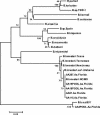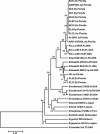Borrelia species in host-seeking ticks and small mammals in northern Florida
- PMID: 15528699
- PMCID: PMC525154
- DOI: 10.1128/JCM.42.11.5076-5086.2004
Borrelia species in host-seeking ticks and small mammals in northern Florida
Abstract
The aim of this study was to improve understanding of several factors related to the ecology and environmental risk of Borrelia infection in northern Florida. Small mammals and host-seeking adult ticks were collected at several sites, and specimens were tested for the presence of Borrelia species, primarily by PCR amplification. Tissues from some vertebrates and ticks were initially cultured in BSK-H medium to isolate spirochetes, but none were recovered. However, comparison of partial flagellin (flaB), 66-kDa protein (p66), and outer surface protein A (ospA) gene sequences from DNAs amplified from small mammals and ticks confirmed the presence of several Borrelia species. Borrelia lonestari DNA was detected among lone star ticks (Amblyomma americanum) at four sites. Borrelia burgdorferi sensu stricto strains were detected in all small mammal species tested and in A. americanum, Ixodes affinis, and Ixodes scapularis ticks. Borrelia bissettii was found in a cotton mouse and cotton rats and in I. affinis ticks. The study findings extend the known geographic distributions of B. lonestari in A. americanum and of B. burgdorferi sensu lato in A. americanum, I. affinis, I. scapularis, and small mammals to new sites in Florida. The presence of B. burgdorferi sensu stricto strains in host-seeking lone star ticks at two sites in Florida suggests that A. americanum should still be considered a possible vector of B. burgdorferi sensu lato.
Figures





References
-
- Altschul, S. F., W. Gish, W. Miller, E. W. Myers, and D. J. Lipman. 1990. Basic local alignment search tools. J. Mol. Biol. 215:403-410. - PubMed
-
- Barbour, A. G., R. H. Heiland, and T. R. Howe. 1985. Heterogeneity of major proteins in Lyme disease borreliae: a molecular analysis of North American and European isolates. J. Infect. Dis. 152:507-516. - PubMed
-
- Barbour, A. G., G. O. Maupin, G. J. Teltow, C. J. Carter, and J. Piesman. 1996. Identification of an uncultivable Borrelia species in the hard tick Amblyomma americanum: possible agent of a Lyme disease-like illness. J. Infect. Dis. 173:403-409. - PubMed
Publication types
MeSH terms
Substances
Associated data
- Actions
- Actions
- Actions
- Actions
- Actions
- Actions
- Actions
- Actions
- Actions
- Actions
- Actions
- Actions
- Actions
- Actions
- Actions
- Actions
- Actions
- Actions
- Actions
- Actions
- Actions
- Actions
- Actions
- Actions
- Actions
- Actions
- Actions
- Actions
- Actions
- Actions
- Actions
- Actions
- Actions
- Actions
- Actions
- Actions
- Actions
- Actions
- Actions
- Actions
- Actions
- Actions
- Actions
- Actions
- Actions
- Actions
LinkOut - more resources
Full Text Sources

